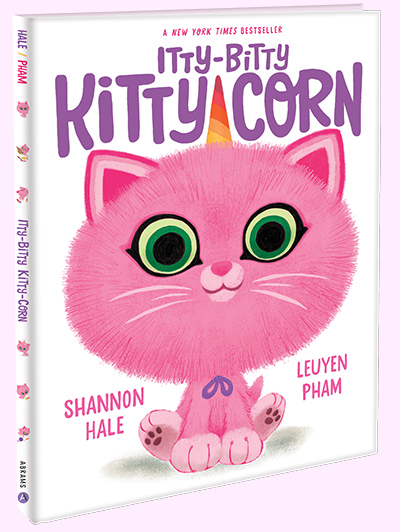Shannon Hale and LeUyen Pham’s Itty-Bitty Kitty-Corn is — pardon the pun — a unicorn: a 40-page, 413-word picture book that my toddler will not only sit through cover-to-cover but request again and again. That’s because it ticks off every box for S’s favorite books:
- A cute, cuddly main character
- A subject S loves (here, animals)
- Onomatopoeia
- Active, colorful illustrations
- Active, short, punchy sentences
- Repetition and word choices that invite interaction from the listener
I’ll take them in turn, though many of these points can easily be combined differently under multiple topic headers. (In short, the reasons this is S’s co-favorite book are self-reinforcing.)
1. A cute, cuddly main character
This one’s pretty self-explanatory. Just look at Kitty:

She’s adorable. And she prances and preens and trots and gambols all the way through the book:

Even when (spoiler alert) Kitty gets sad, she remains utterly adorable. You just want to give her a big hug. S loves to look at all the pictures of Kitty throughout the book, helping to hold S’s attention through the text.
2. Animals
This one’s also pretty self-explanatory. S loves animals, and this is a book with animal characters. I will note that the type of animals in the book was not a selling point; just the mere fact of animal characters was what did it. Prior to reading this book, S was not into kitties, unicorns, geckos, or parakeets, but S left the book a fan of kitties, unicorns, and kitty-corns.
3. Onomatopoeia
Itty-Bitty Kitty-Corn uses well-placed, fun onomatopoeia. Kitty “neighs” (a favorite animal sound that immediately endeared the book to S). Her tail goes “poof.” The unicorn goes “clop clop.”
The onomatopoeia is not over the top, but sprinkled in only where it makes sense to move the story along. And S loves to chime in with it.
4. Active, Colorful Illustrations
You can get a sense of this from some of the pictures above, but Kitty is constantly moving. Her expressions and actions change across and down the page.
The fact that the illustrations frequently feature Kitty doing multiple different things on a given page help hold S’s attention — there are lots of varied illustrations that S can look at while I read the corresponding sentences, which makes it much easier to get through longer text blocks (and presumably make it easier for S to understand what the text is conveying when it uses new words).

5. Active, Short, Punchy Sentences
Itty-Bitty Kitty Corn may be on the absolute high end of word count for books S and I read together, but it does not feel long in the slightest. Shannon Hale’s text is phenomenally tight. Sentences are short, punchy, and active (and often tied to individualized illustrations per sentence). There are frequently no more than 2-3 sentences on a page. Those sentences are often no more than 5 words, making them easier for a young reader to follow (and adding to the rhythm of the story). Dramatic pauses are built into the writing, and also to the text layout:

6. Repetition and Interactive Sentences
Itty-Bitty Kitty-Corn makes great use of repetition and near repetition, as well as interactive sentences that let S anticipate and join in with me. S especially loves the onomatopoeia and saying “up up up” along with me.
***
TL;DR – this book is adorable, and does so many things right for appealing to multiple age groups. I can easily see it remaining a favorite for a long time.
Some quick stats on Itty-Bitty Kitty-Corn:
Page count: 40 pages of what I would consider the “main” book
Word count: 413
Average word count per illustration: 10.86 (or 10.33 if you count standalone pages of text with pretty font as their own illustration)
Average sentence length: 5.9 words per sentence (or 6.16 if you include semicolons and sentences that were broken over multiple pages and illustrations as single sentences)
